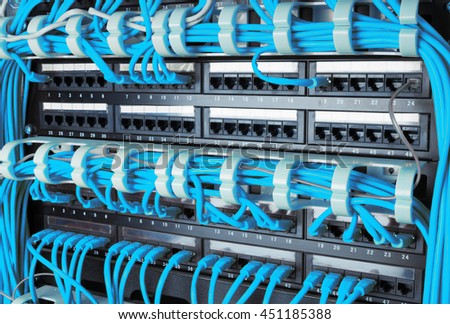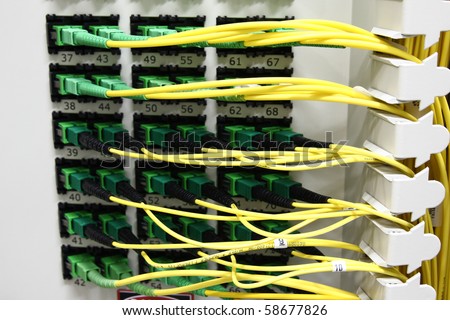Internet Patch Panel
I'm planning a home network in a house that's not built yet. One recommendation is to add network sockets in various rooms and have them all end in a central place, where it all connects using a network switch.
A panel reduces wear and tear on the wiring since it is connected on the back of the panel and limits user access once the wiring is installed. From the patch panel, small patch cables plug into a port on the panel, and then the cable plugs into the switch. Nov 01, 2011 How to Punch Down a Network Ethernet Patch Panel Discount Low Voltage. Bundling Ethernet Cable with the Cable Comb and Terminating a Patch Panel. 1-24 of over 1,000 results for Electronics: 'ethernet patch panel' 'ethernet patch panel' Cancel. Amazon's Choice for 'ethernet.
So far so good. Another recommendation says to not connect everything directly to the switch, but to a patch panel which in turn is connected to the switch. I'm unsure why this is good. Is there any practical advantage of using a patch panel if you're not planning to re-wire things very often?. How does a patch panel actually work? Let's say it has 24 ports. Does it have another 24 ports on the backside that go to the switch, or what?
Isn't helpful on this. Clarification: I am planning to run network cables through conduits inside the walls and terminated with network sockets in the wall (as opposed to having just conduits and long regular network cables that have a normal plug in each end). Going by RedGrittyBrick's answer, a patch panel is nearly unavoidable in that case.

First of all, have a look at from DIY.SE. Now, if we have a look at the picture in the question: The Dell switch is sitting above two patch panels. The patch panel would then run cables out to a socket that would be mounted against a wall and then you would use a normal Cat5/6 cable to plug into the wall and into your desktop/computer. If you just had a cable connected to the switch, through the wall, and into the back of the computer, you are limited to the length of the cable. A patch panel would mean a bit more effort and only the most hardcare would really care about having one - it would look a bit more tidy. For the wiring standards for the network cable has some good pictures. To answer your questions:.
Not nessicarily. It's probably down to personal preference - patching in a number of cables can lead to numb fingers - and makes it look neater than having cables trailing from a switch. A patch panel would have, as you say, 24 ports on the front. This is the rear of a patch panel - each port has 6 connections that are made up to the networking standard - and is also patched into the wall plate at the other end. Image of the back of a wall-mountable patch panel. All professional installations in offices use patch panels. Even in quite small offices.
How To Patch Panel

A patch panel has the solid-cored cable connected in at the rear using a punch down style of connection. At the front it has 8P8C sockets (casually called RJ45 sockets). Into these sockets you can plug Ethernet patch cables (which have stranded conductors unlike the cables used in walls) The cables used in walls is stiff which would be inconvenient for use with a switch and would need non-standard termination due to the different type of conductors.
You can't easily use patch cable in walls as wall-plates (the Ethernet outlets) are typically designed for solid core cable punch-down. Staying with the standard way of wiring buildings will probably save you trouble in the future when a wall-plate needs replacing or extra cables are run by a different contractor. I was a builder for 15 years before becoming a computer geek; so when we recently added an addition to our house, I pulled 1' plastic conduit to every low-voltage box in the house. Because the cat6a I'm pulling today will be obsolete before I move out. affordable?
Well, the conduit cost about $300 and my labor is worthless (or priceless) I used smurf tube for the tricky bits and straight tube everywhere else. It all goes into the basement and everything runs into the rack. Solid wire for the premise wiring; so yes, a patch panel. You can use a patch panel for your catv coax too. However, F-connectors suck. Consider a BNC patch panel you can still find them on e-bay.
Phase Phase is used to describe the two main types of alternating current (AC) electric power produced by a utility, generator or UPS system. Single-phase power includes a single AC waveform, making single-phase equipment ideal for lower power density applications with per-rack power consumption levels up to approximately 2.8kVA (120V), 5kVA (208V) or 7.4kVA (230V). Three-phase power includes 3 AC waveforms, making 3-phase equipment better suited for intermediate and high-capacity applications with per-rack power consumption levels that surpass the practical energy limits of single-phase equipment. PDU Type Basic PDUs All PDUs including Basic PDUs provide reliable rack-mount power distribution for data centers, server rooms, and network wiring closets.
Metered PDUs Metered PDUs monitor load levels to avoid potential overloads via a LCD display. Monitored PDUs Monitored PDUs remotely monitor voltage, frequency, and load levels via a built-in network connection. Switched PDUs Switched PDUs can securely control individual outlets remotely to enable the rebooting of unresponsive equipment to minimize downtime. Auto Transfer Switch (ATS) PDUs ATS PDUs provide redundant power to connected equipment with separate primary and secondary power sources.
Hot-Swap PDUs Hot-Swap PDUs have dual input power cables to enable live-replacement of select UPS systems with no power interruption to connected equipment. Technology. Apple® 30-Pin Dock. Cat3. Cat5/5e.
Cat6. Cat6a. Coax. Component. Composite. CX4.
DB25. DisplayPort (all types). DVI (all types). FireWire. HDBaseT. HDMI (All types).
IR. Lightning. Mode Conditioning. Modem. MTP/MPO.
Multimode( All versions). Null Modem. Parallel. PS/2. RG59/RG6.
Ribbon/Internal. SAS. SATA/eSATA. SCSI. Serial (RS232).
SFP+/QSPP+/QSFP28. Singlemode.
Stereo Audio. S-Video.
T1. Toslink/SPDIF. USB (all versions). USB 2.0 (High Speed). USB 3.0 (SuperSpeed). USB 3.1 (Gen 1).
VGA/SVGA. USB 3.1 (Gen 2). A/V over IP. PCIe. Side A - Connector 1. 110 (MALE). 110 IDC.
12-STRAND MTP (FEMALE). English grammar for students of french pdf. 12-STRAND MTP (MALE). 13W3 (FEMALE). 15 PIN SATA POWER.
15 PIN SATA POWER (FEMALE). 15 PIN SATA POWER (MALE). 22 PIN SATA + POWER (FEMALE). 24-STRAND MTP (FEMALE).
24-STRAND MTP (MALE). 3.5MM (FEMALE).
3.5MM (MALE). 3.5MM, 4-POSITION (FEMALE). 30 PIN APPLE (MALE). 30 PIN SAMSUNG (MALE). 4 PIN (INTERNAL).
4 PIN (MALE). 40 POS. Side B - Connector 1. 110 (MALE). 110 IDC. 12-STRAND MTP (FEMALE).
12-STRAND MTP (MALE). 13W3 (FEMALE). 15 PIN SATA POWER. 15 PIN SATA POWER (FEMALE).
15 PIN SATA POWER (MALE). 22 PIN SATA + POWER (FEMALE). 24-STRAND MTP (FEMALE). 24-STRAND MTP (MALE). 3.5MM (FEMALE).
3.5MM (MALE). 3.5MM, 4-POSITION (FEMALE). 30 PIN APPLE (MALE). 30 PIN SAMSUNG (MALE).
4 PIN (INTERNAL). 4 PIN (MALE). 40 POS.